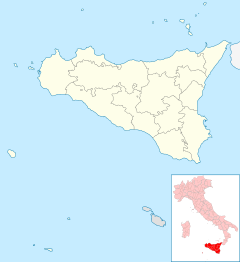Cathedral of Syracuse/Duomo di Siracusa
Cathedral of Syracuse/Duomo di Siracusa
Syracusa, Sicily, Italy
| Cattedrale metropolitana della Natività di Maria Santissima | |
|---|---|
| Basic information | |
| Geographic coordinates | 37°03′35″N 15°17′36″ECoordinates: 37°03′35″N 15°17′36″E |
| Region | Sicily |
| Country | Italy |
| Architectural description | |
| Architectural type | Cathedral |
| Architectural style | Sicilian Baroque |
| UNESCO World Heritage site | |
| Part of | Syracuse and the Rocky Necropolis of Pantalica |
| Criteria | Cultural: (ii)(iii)(iv)(vi) |
| Reference | 1200-003 |
| Inscription | 2005 (29th Session) |
"The Cathedral of Syracuse (Duomo di Siracusa), formally the Cattedrale metropolitana della Natività di Maria Santissima, is an ancient Catholic church in Syracuse, Sicily, the seat of the Roman Catholic Archdiocese of Siracusa. Its structure is originally a Greek doric temple, and for this reason it is included in a UNESCO World Heritage Site designated in 2005.[1] The cathedral stands in the city's historic core on Ortygia Island." (Link 1)
Duomo Frontal Statue
"The present cathedral was constructed by Saint Bishop Zosimo of Syracuse in the 7th century. The battered Doric columns of the original temple were incorporated in the walls of the current church. They can be seen inside and out.[3] The building was converted into a mosque in 878, then converted back when Norman Roger I of Sicily retook the city in 1085. The roof of the nave is of Norman origin, as well as the mosaics in the apses.
"As part of the increased building activity after the 1693 Sicily earthquake, the cathedral was rebuilt and the façade redesigned by architect Andrea Palma in 1725–1753. The style is classified as High Sicilian Baroque, a relatively late example. The double order of Corinthian columns on the facade provide a classic example of carved Acanthus leaves in the capitals. Sculptor Ignazio Marabitti contributed the full-length statues on the facade.
"The interior of the church, a nave and two aisles, combine rustic walls and Baroque details. Features include a font with marble basin dating from the 12th or 13th century, a ciborium (an altar canopy) designed by architect Luigi Vanvitelli, and a statue of the Madonna della Neve ("Madonna of the Snow", 1512) by Antonello Gagini."(Link 1.)
Duomo Pillar Detail
Duomo fountain
Ortigia (/ɔːrˈtɪdʒiə/; Italian: Ortigia; Greek: Ὀρτυγία) is a small iss from the Ancient Greek ortyx (ὄρτυξ), which means "Quail". (Link 2,)landwhich is the historical centre of the city of Syracuse, Sicily. The island, also known as Città Vecchia (Old City), contains many historical landmarks. The name originate
*******
Link 1: https://en.wikipedia.org/wiki/Cathedral_of_Syracuse
Link 2: https://en.wikipedia.org/wiki/Ortygia
Prayer
God, be with persecuted Christians throughout the world. Amen (SW.)







No comments:
Post a Comment